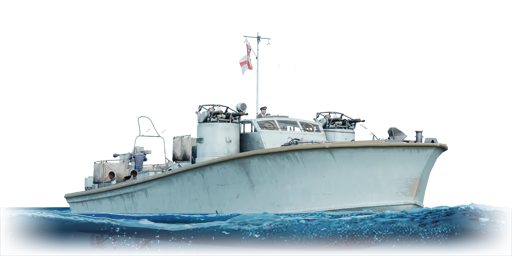

Coastal Fleet
MGB-61
I
Rank
AB
1.7
RB
1.7
Battle rating
Great Britain
Research country
Boat
Main role
5,900

Research
6,300

Purchase
General information
Specification
Armour
Hull
40 mm (wood)
Superstructure
15 mm (wood)
Number of sections
3
Displacement
34 t
Crew
12 persons
Max speed
Forward
74639973 km/h
Backward
20172720 km/h
Primary armament
2 × Turret — 2 × 12.7 mm Vickers Mk.V machine gun
Ammunition
8,000 rounds
Belt capacity
200 rounds
Reload
basic crew → aces
13 → 10 s
Fire rate
600 shots/min
Vertical guidance
-10 / 70°
Turret Rotation Speed
Horizontal
7563.87563.8 °/s
Vertical
7563.87563.8 °/s
| Belt | Belt filling | Armor penetration (mm) at a distance: | |||||
|---|---|---|---|---|---|---|---|
| 10 m | 100 m | 500 m | 1000 m | 1500 m | 2000 m | ||
| T/AP/HEI | 24 | 24 | 21 | 18 | 16 | 15 | |
| T/HEI/HEI/HEI | 20 | 19 | 16 | 14 | 12 | 11 | |
| T/AP/HEI/AP | 24 | 24 | 21 | 18 | 16 | 15 | |
Secondary armament
40 mm 2pdr Rolls Royce semi-automatic cannon
Ammunition
1,200 rounds
Belt capacity
4 rounds
Reload
basic crew → aces
2.2 → 1.7 s
Fire rate
231 shots/min
Vertical guidance
-12 / 60°
Turret Rotation Speed
Horizontal
4538.34538.3 °/s
Vertical
5546.85546.8 °/s
| Belt | Belt filling | Armor penetration (mm) at a distance: | |||||
|---|---|---|---|---|---|---|---|
| 10 m | 100 m | 500 m | 1000 m | 1500 m | 2000 m | ||
| HEF/AP-T/HEF/AP-T | 60 | 57 | 50 | 43 | 38 | 34 | |
| HEF/HEF/HEF/AP-T | 60 | 57 | 50 | 43 | 38 | 34 | |
| AP-T/AP-T/AP-T/HEF | 60 | 57 | 50 | 43 | 38 | 34 | |
Additional armament
Setup 1
2 × Mk.VII depth charge
Economy
Repair cost
Basic → Reference
AB
296 → 373 

RB
444 → 560 

Crew training
1,800 

Experts
6,300 

Aces
80 

Research Aces
135,000 

Reward multiplier
AB / RB
30 / 40 % 

106 % 

Total cost of modifications
5,920 

4,470 

Talisman cost
410 

Research order:
Seakeeping |
|---|
Unsinkability | |
|---|---|
Firepower | ||
|---|---|---|
Rating by players
You must play more than 3 battles for the last week and more than 10 battles in a vehicle to rate it.
Like:
3
Armor protection:
Not enough ratings
Survivability:
Not enough ratings
Mobility:
Not enough ratings
Armament:
Not enough ratings
Balance:
Not enough ratings
Tips & Tricks
This space is currently empty
Do you know any interesting vehicle features?
Loading...
No articles about this vehicle yet
Become the first author and get rewards!
Write a guide, tell about interesting historical facts, make a tutorial or simply an interesting post.
No more content